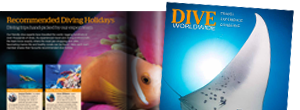Muck diving, or critter diving, is as fascinating as it is addictive. From the wunderpus to the pygmy seahorse, our muck diving trips take you to the best locations to uncover the weirdest and most wonderful creatures on the planet.



Why our muck diving holidays are so successful




Muck diving
Despite its less than glamourous name, muck diving has become hugely popular in recent years. Learn about muck diving and discover why it is such a unique and addictive form of diving.
Gain an insight into the iconic species you can encounter whilst muck diving and where you may be lucky enough to see them, with some great trip ideas to inspire you.
What is muck diving

These environments hide some true masters of camouflage such as unusual species of frogfish, seahorses, all manner of octopus and so much more. Muck diving destinations tend to be especially popular with underwater photographers searching for that special shot.
Milne Bay in Papua New Guinea was the birthplace of muck-diving and the Asia Pacific region has a monopoly on muck diving sites due to the region’s biodiversity. The Lembeh Strait - often referred to as the engine room of evolution - is considered the finest muck diving location of all, while Bali, Ambon and the Philippines’ Dumaguete area also reward divers with a vast array of unusual species, along with many excellent reefs to enjoy as well.
Why muck dive

As many of the species are slow moving or primarily stationary, they represent excellent opportunities for underwater photographers to hone their skills. Whereas with larger marine life, you often only get one shot, many species found muck diving allow for a more considered approach and some exceptional images as a result.
Due to the array of unusual species, muck diving is also very educational and allows divers to gain greater knowledge about specific species and the diversity of these exceptional areas.
Iconic muck diving species

Discovered in Indonesia in 1998, the mimic octopus (Thaumoctopus mimicus) is another wonderful species that can be encountered while muck diving in the Asia Pacific region. Widely regarded as one of the most intelligent species in our oceans, they have developed the ability to change their shape, colour and texture in order to mimic other marine life, taking on the form of lionfish, sea snakes, flatfish and jellyfish and many more. No other species is known to use mimicry to this extent. This allows them approach prey unnoticed and also defend themselves against possible predators.
They can be found, along with their close cousins, the fabulously named Wunderpus (Wunderpus photogenicus) in the Indo Pacific region, most notably Lembeh Strait and Ambon.
Frogfish are another favourite among divers. Unlike other creatures found while muck diving, they are not unique to the Asia Pacific region and are found globally. However, the diversity of the Coral Triangle ensures that the greatest variety and most striking species are found in this region.
Frogfish tend to be masters of camouflage and spend much of their time stationary on the reef or sea floor, blending in seamlessly with their background. They possess a lure, which they use much like a fishing rod to attract prey. Once within range, the frogfish strikes with extraordinary speed, extending their mouths up to twelve times their size and devouring their prey. Slow motion cameras have revealed this action to be as quick as six milliseconds, one of the fastest actions of any animal!
Favourite species amongst divers include the giant frogfish (Antennarius commerson), clown/warty frogfish (Antennarius maculatus) (see above left) and painted frogfish (Antennarius pictus). The best locations to see them are Lembeh, Dumaguete and Ambon, but they can be seen throughout Indonesia, the Philippines, Malaysia and Papua New Guinea.









